Tag Archive: strategies
August 24, 2013
by Robin Parker -
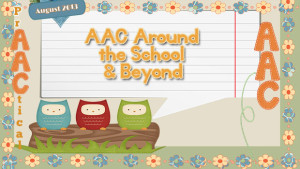
For the August Strategy of the Month, we have been thinking, writing, & talking about AAC in School. School is where AAC learners spend a large portion of their days. There needs to be multiple opportunities for students to USE and LEARN AAC each day. More than that though, we strive for full participation and interaction for students who use AAC. Students should not have to prove that they can do these things before they have ACCESS to AAC strategies and intervention. Here are some things that can be done to help build AAC participation for both students and educators. Provide ACCESS to AAC devices and visual supports throughout ALL activities in ALL places in school and on school sponsored trips/community based instruction. Provide Aided Language Input when teaching AAC to students. Use a Core Word approach when teaching AAC to students but don’t forget about Fringe Vocabulary. Learn and use partner assisted communication... [Read More...]
Filed under: Strategy of the Month
Tagged With: communication, inclusion, language, resources, strategies
June 13, 2013
by Carole Zangari -
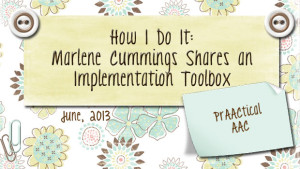
Now that the school year is winding down, some of you have a little more time to read, process, and prepare for next year. We are really excited to share more ideas from Marlene Cummings, one of the most experienced AAC SLPs that we know. Those of you who have been following Marlene’s posts on the AAC implementation will be pleased to see the next part of the Framework for Success that she developed with the AAC Team at Oakland School District. If you missed her first and second posts, go take a peek at them when you can. 5 Things in our “Implementation Toolbox” When we begin the process of implementing AAC it is important to consider our “thinking”. We always want to approach every student, every team and every classroom with as much wisdom and respect as possible. One of my colleagues, Dr. Penny Hatch, from UNC Chapel Hill... [Read More...]
Filed under: PrAACtical Thinking
Tagged With: AAC team, classroo, education, Marlene Cummings, schools, strategies
May 12, 2013
by Carole Zangari -
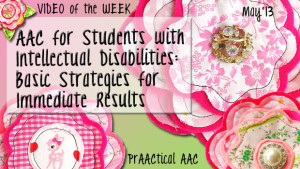
A good number of SLPs in school settings serve students with intellectual disabilities, some of whom who use or need AAC. In this video by ASHA, Dr. Krista Wilkinson and Ellen Kravitz of Easter Seals in Massachusetts, discusses many prAACtical issues that arise in doing this work. A number of years ago when I was the Coordinator for the ASHA Special Interest Division on AAC, I had the opportunity to work with a team of SLPs who were fully committed to educating SLPs about AAC. Ellen spearheaded the effort to create this webinar, along with the support of Diane Paul, Karen Niles, and many other wonderful people at the ASHA National Office. We were delighted to host ASHA’s media team at our university SLP clinic to do some of the taping for this program. Thanks to the generosity of ASHA and ASHF, this presentation is offered both in the free version and... [Read More...]
Filed under: Video of the Week
Tagged With: ASHA, cognitive impairment, Ellen Kravitz, intellectual disability, Krista Wilkinson, strategies
March 23, 2013
by Robin Parker -
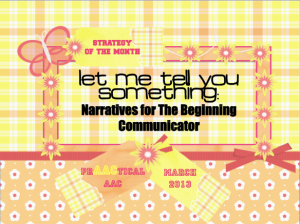
March continues with story telling or narratives as the Strategy of the Month. All learners have stories to tell but some may need special teaching to be able to express their stories. Goals for the beginning communicator can and should include narratives. Personal narratives are a good place to begin but any type of narrative can be taught with structure, routines, partner support, prAACtical strategies. Robust communication includes story telling. Yes, beginning communicators need to be able to express wants and needs however, authentic and comprehensive language involves much more. The quicker we start teaching, the quicker beginning communicators (or anyone) can learn. Beginning Communicator Narratives 3 Types (Just some of the options) Remnant Books are a visual and tactile way of telling stories by recording important events. Learners can help choose items from meaningful personal experiences which serve as a reminder of stories to tell. Create routines and visual supports... [Read More...]
Filed under: Strategy of the Month
Tagged With: beginning communicator, narratives, strategies
November 6, 2012
by Carole Zangari -
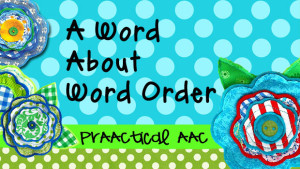
Lots of AAC learners make mistakes when they assemble words into sentences. Here is a brief screencast talking a little bit about what to think about when providing therapy to individuals with syntax errors. –
Filed under: PrAACtical Thinking
Tagged With: aided language input, intervention, language therapy, strategies, syntax, word order
July 28, 2012
by Robin Parker -
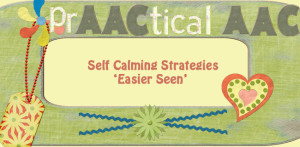
Throughout this month we focused on visual supports & strategies for positive behavior. We have discussed transition supports, environmental arrangements, and consequence mapping. As we wrap up, we don’t want to forget PrAACtical AAC strategies for self-calming. We like to think about self-calming like this- some weeks we need it more than others, some days we need it more than others. We all need self- calming strategies. Whether we vent to a friend, go for a run, knit, take deep breaths, or get a glass of wine (although we are not advocating this), we all use self-calming strategies. It makes a huge difference. Sometimes though helping our students self-calm at times may seem “easier said than done”, but we know it truly is ‘easier when SEEN‘. Self-calming strategies can help before, during, and after behavior challenges . We will often teach and use self calming strategies if we know a potentially stressful situation will... [Read More...]
Filed under: Strategy of the Month
Tagged With: Challenging Behavior, resources, Self-Calming, strategies, visual supports
January 6, 2012
by Robin Parker -
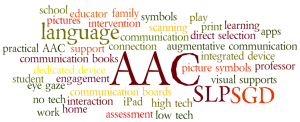
We know that ALL people communicate. However, when someone has communication challenges, their signals may not always be obvious or conventional. Here is our Quick Step Guide to getting to know about someone’s specific communication. Using these steps will help facilitate spontaneous communication and move communication along the continuum of conventionality and symbolism. 1. Observe: What are they doing that is potentially communicative? Look for clues in behaviors. Consider proximity, persistence, expressions, repetition, intensity, or anything else that might expresses a message. More ideas from the National Consortium on Deaf-Blindness. Great information that is applicable to a wide range of early communicators. Don’t rule this out until you’ve looked at it. 2. Interpret: What does that behavior mean? Think about what would they ‘say’ if there was no communication problem. It can be a positive message (‘I want that’, ‘oh come on pretty please’) or a negative message... [Read More...]
Filed under: PrAACtical Thinking
Tagged With: communication, Opportunities, strategies






